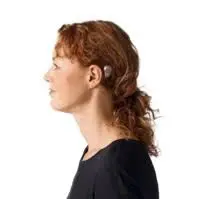
Conductive Hearing Loss: Causes and Treatments
Bone-anchored hearing system (picture: en.wikipedia.org)
There are three main types of hearing loss: Sensorineural hearing loss – the most wide-spread; conductive hearing loss – often underrated and neglected; mixed hearing loss – a combination of sensorineural and conductive. Do you know your type?
Conductive hearing loss due to obstructed sound flow
For normal hearing, sound energy travels freely via “air conduction” from the external ear through the middle ear and on to the inner ear’s hearing organ, the cochlea. Air conduction is one way of how we hear and conventional hearing aids depend on it for proper function.
Conductive hearing loss is the result of something getting in the way of the free-flowing, air-conducted sound. The problem lies with the external and /or middle ear structures. Soft sounds disappear while others seem muffled or far away.
Some common causes for conductive hearing loss
Conductive hearing loss can be temporary and resolve itself once the problem is diagnosed and treated. One might think of fluid build-up in the middle ear due to colds, allergies and infections, malfunctioning Eustachian tubes that don’t drain the middle ear properly and cause pressure sensations, ear wax plugs etc.
Reasons for more serious and permanent cases of conductive hearing loss are malformed outer ears; damaged or rigid ear drums, middle ear growths or malfunction of the 3 middle ear relay ossicles due to trauma or stiffening. In some cases, surgery may correct the problem or clear the path enough to allow for the use of conventional hearing aids. In other cases, bone-conduction hearing aids are needed.
Get tested!
And so, not all hearing loss is the same. The only way to diagnose the type of hearing loss is to get professionally tested. These tests go beyond listening to “beeps.” They isolate the different parts of the ear and locate the problem area(s). That information then helps the specialist with targeted treatment decisions. A referral to an Ear, Nose and Throat (ENT) doctor is often necessary for complicated sound conduction issues.
Bone conduction hearing help
The second way of how we hear is through “bone conduction.” Bone conduction hearing is tested by attaching a vibrator or oscillator to the patient’s forehead or back of the head. Sound is translated into vibrations that are transmitted directly to the inner ear cochlea by means of the skull and jaw bones ─ bypassing the outer and middle ear sections.
If the cochlea and the hearing nerve function normally, those with a conductive hearing loss can get much improved hearing via bone conduction systems.
Non-surgical and implantable options
Many are familiar with bone-conduction headphones for listening to music. Not too long ago, a similar looking, behind-the-head, external bone-conduction aid was released onto the market. Designed especially for children, this might also please adults. Again, especially for young children, oscillating sound processors can also be applied to the head with a soft headband.
However, adults with serious conductive problems are mostly treated with implantable bone-conduction hearing systems produced by various manufacturers. These are totally different from cochlear implants! Under certain conditions, a middle-ear implant might be considered for a conductive loss.
Overseas, bone conduction aids integrated with eyeglasses are also offered. Why are they not sold here? They actually look kind of cool.
And so, anybody who has unrelenting trouble hearing should get professionally tested. As anywhere else in medicine, in order to get the correct treatment, one needs a correct diagnosis. And hearing loss is no different.
Note: Links to websites are for information and illustration only. The author does not favor any brand, manufacturer or distributor over another.
****
For Industry Hearing Safety Training or for general presentations on Hearing Loss and Prevention, please see this website or email monique.hearing@gmail.com
Zoom Presentations available.
Interested in Hearing Loop Technology for better hearing in loud places? Check out loopminnesota.org